Tamil Nadu is not only the ‘Land of Tamils’ but also a land of heritage and historic sites. Uncountable historical monuments in Tamil Nadu make the state a paradise for history buffs. Magnificent temples that are architectural masterpieces bless the place with a divine aura. Rulers of different dynasties have shown their craftsmanship in the form of historic wonders that were constructed over the years. These sites of the bygone era are amazing evidences to the rich Dravidian culture and art.
Rulers of the Chola, Nayak, Pallava, Vijayanagara, Pandya dynasties, who were great patrons of architecture and art have bestowed each monument with a distinctive style. So, let’s take a tour to heritage and historical sites in Tamil Nadu without any further delay.
Brihadeeswarar Temple, Thanjavur

Nestled in Thanjavur is the Brihadeeswarar Temple, one of the largest temple in South India. Dedicated to Lord Shiva, the temple lures many pilgrims to seek the blessings of the almighty. A part of the UNESCO World Heritage Site, the shrine boasts of an imposing tower, frescos, inscriptions and sculptures. A giant statue of the Nandi welcomes visitors at the entrance of the ‘Big Temple’. The most popular temple of Tamil Nadu is known by alternative names like Peruvudaiyar Kovil or Rajarajesvaram.
Built in – Between 1003 and 1010 AD
Built by – Raja Raja Chola I of the Chola Dynasty
Interesting Facts – The Vimana tower above the shrine is one of the tallest in South India. The sanctum sanctorum houses one of the largest Shiva Lingams.
Airavatesvara Temple, Darasuram
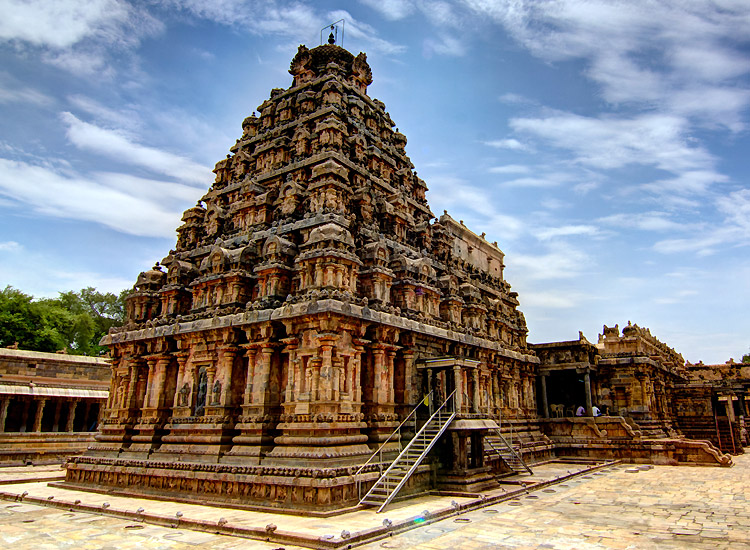
The Airavatesvara Temple along with the Brihadisvara Temple of Thanjavur and Gangaikondacholapuram forms the Great Living Chola Temples, a UNESCO World Heritage Site. Situated in Darasuram, the sacred place is dedicated to Lord Shiva who is worshipped here in the form of Airavat, Lord Indra’s elephant. Featuring the Dravidian architectural style, the sacred place is worth exploring and is one of the popular temples of Tamil Nadu. Various mythical creatures known as Yalis are carved on the pillars of the temple.
Built in – 12th Century AD
Built by – Raja Raja Chola II of the Chola Dynasty
Interesting Facts – Many legends are associated with the temple. The steps to the temple are another interesting aspect which produce all the seven notes ‘swaras’ of music when tapped on.
Shore Temple, Mahabalipuram

Overlooking the shore of the Bay of Bengal is the splendid Shore Temple. The structural temple is made up of blocks of granite and is a standing tribute to the royal heritage of India. Unlike the historical monuments in Tamil Nadu, the holy place consists of five-storied rock-cut structural temple. Counted as a part of the Group of Monuments at Mahabalipuram, the Shore Temple is a UNESCO World Heritage Site. The shrine is famed for portraying an exclusive blend of natural splendor and history.
[Read about the most popular places of Tamil Nadu.]
Built in – 700–728 AD
Built by – Narasimhavarman II of the Pallava Dynasty
Interesting Facts – The Shore Temple stands as a backdrop in the Mahabalipuram Dance Festival which is held annually in the month of Jan/Feb. The temple is also recognized as the first stone structure created by the Pallavas. The motive behind the designing of the temple was to capture the initial rays of the rising sun and to spot the waters after the dusk.
Sri Meenakshi Temple, Madurai

Known with various names like Minakshi-Sundareshwara Temple or Meenakshi Amman, the Meenakshi Temple is nestled in the temple city of Madurai. Goddess Parvati, consort of Lord Shiva is the presiding deity here. One of the most iconic and historic temples of Tamil Nadu, the shrine houses four main entrances and towers facing in four different directions. A 1000 pillared hall grabs the attention instantaneously. Beside this, other attractions are the musical pillars and the holy golden lotus tank.
Built in – The original time of the construction of temple has deep roots in the history. However, it is believed that the holy shrine was built in the 6th century BC.
Built by – Different parts of the temple are built by different persons. But, as per the common beliefs, the temple was originally built by the survivors of the Kumari Kandam.
Interesting Facts – The Meenakshi Amman temple is a perfect blend of the myths, legends and stunning architectural techniques. Approximately 33,000 sculptures adorn the temple. The colossal Nataraja sculpture is hemmed in a giant silver altar and hence known as the Velli Ambalam.
Kapaleeshwar Temple, Chennai

Kapaleeshawar Temple is holy abode of Lord Shiva and is one of the most revered temples of Tamil Nadu. The impressive gopuram is a striking evidence of the Dravidian style of architecture. Although the temple is dedicated to Hindu God Shiva, it is interesting to note that his wife Parvati is worshipped at the temple in the form called as Karpagambal. The word Karpagambal means Goddess of the Wish-Yielding Tree. The area in which the temple is built derived its name from the form in which Goddess Parvati used to worship Lord Shiva. The Goddess used to pray Lord in the form of peacock (Mayil in Tamil) and hence the name Mylapore.
[Also read about fascinating historical places of South India.]
Built in – 7th century CE
Built by – Pallavas
Interesting Facts – A 37-meter tall gopuram overpowers the street where the temple is situated.
Group of Monuments at Mahabalipuram, Mahabalipuram

A collection of nearly 400 ancient religious monuments is termed as Group of Monuments at the Mahabalipuram. This cluster of the historical monuments in Tamil Nadu also appears in the list of UNESCO’s World Heritage Site. The monuments were carved out of rocks along the Coromandel Coast. Praiseworthy features add to the architectural grandeur of the monuments, which are mainly mandapas, rathas, the temple of Rivage and massive open-air reliefs. The monuments artistically feature prehistoric architectural brilliance.
Built in – 7th – 8th century CE
Built by – Pallavas
Interesting Facts – Of the nine monolithic temples found in Mahabalipuram, the most prominent are the Five Rathas. These five Rathas temples are known after the famous five Pandava brothers from the Hindu epic Mahabharata. The monuments are sculpted out of a single rock.
Vivekananda Rock Memorial, Kanyakumari
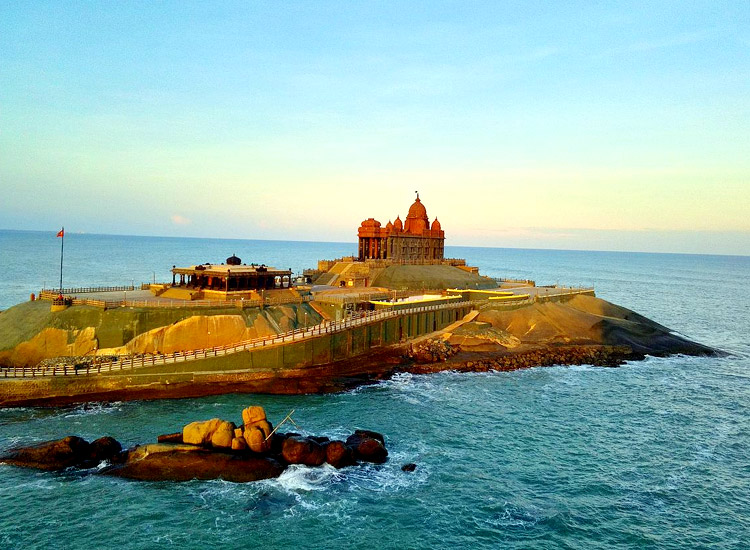
The spectacular architecture of the Vivekananda Rock Memorial makes it a popular monument in Tamil Nadu. Perched on a small island of Kanyakumari, the memorial offers serenity and peace to the visitors. It takes an exciting ferry ride to reach the Island which houses two adjacent rocks comprising of the ‘Vivekananda Mandapam’ and the ‘Shripada Mandapam’. The memorial stands as an undying source of inspiration highlighting the noble deeds of Swami Vivekananda. It is also an epitome of unity as the whole nation wished, contributed and worked for it.
[Check out our customized Tamil Nadu tour package.]
Built in – 1970
Built by – Kanyakumari Committee and Ramakrishna Mission in Madras planned for the construction of the memorial.
Interesting Facts – The statue of Swami Vivekananda is positioned in such a way that his vision directly falls on the Shripadam. A perfect confluence of the Bay of Bengal, the Indian Ocean and the Arabian Sea can be witnessed from here.
Ramanathaswamy Temple, Rameswaram
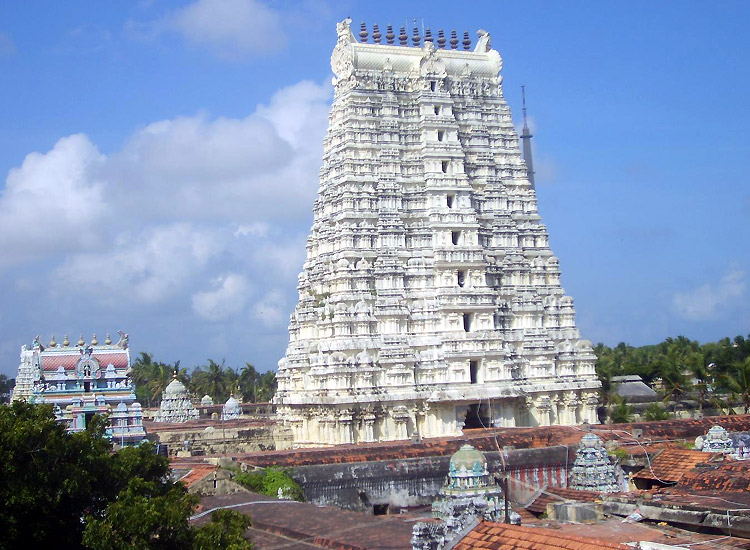
Ramanathaswamy Temple is one of the holiest shrines of India. The temple houses one of the twelve Jyotirlingas of Lord Shiva. As per the beliefs, the holy lingam was setup by Goddess Sita, so that her husband Lord Ram can worship the God. Rameshwaram is also famed as one of the destinations of the popular Char Dham Yatra. Thus, pilgrims from all over the world visit this popular temple of Tamil Nadu with great devotion. Other than this, the shrine is also famed for having the world’s longest set of corridors.
Built in – 12th century
Built by – Pandya Dynasty
Interesting Facts – There are two lingams within sanctum sanctorum. One was made by Sita and the other one was brought by Lord Hanuman from Kailash and is called as Vishwalingam. As per the directions of Lord Rama, Vishwalingam is worshipped first.
Sri Ranganathaswamy Temple, Tiruchirappalli
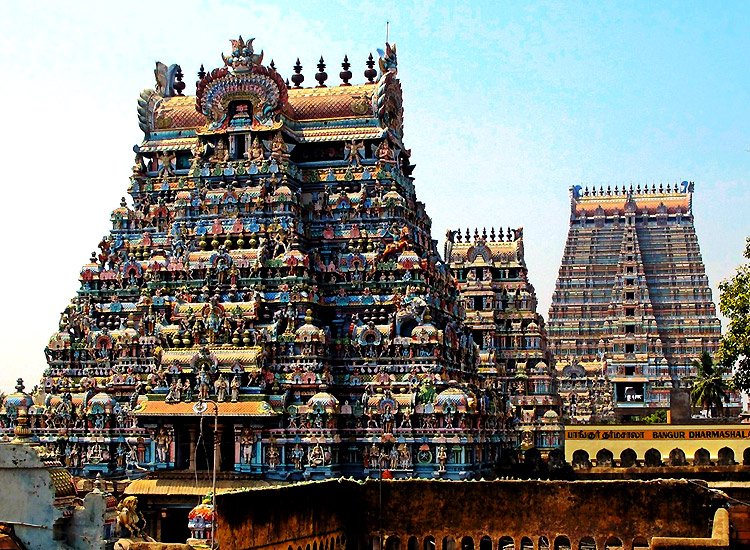
Dedicated to Lord Vishnu, Sri Ranganathaswamy Temple in Tiruchirappalli is revered as the first, foremost and most important of the 108 Divyadesams (main temples of Lord Vishnu). The sanctum sanctorum is known by various names like Periyakoil, Thiruvaranga Tirupati, Bhogamandabam and Bhoologa Vaikundam. Representing the Dravidian style of architecture, it is one of the most eminent Vaishnava temples in South India rich in history and legend. The shrine consists of 21 outstanding towers and 7 enclosures. Not only the architecture but also the location of the temple is noteworthy as it lies on an island amidst the Kollidam and Cauvery rivers.
[Read about must-see historical architectures of India.]
Built in – As per the evidences, the temple originated in 1st century CE during the Sangam period.
Built by – Several royal dynasties have contributed for the construction of the temple. However, the first amongst them were the Cholas.
Interesting Facts – Millions of devotees gather at the temple during the annual festival which is celebrated for 21 days during the Tamil month of Margazhi. Sri Ranganathaswamy Temple also appears in the tentative list of UNESCO World Heritage Site.
Kolukkumalai Tea Estate, Kottagudi
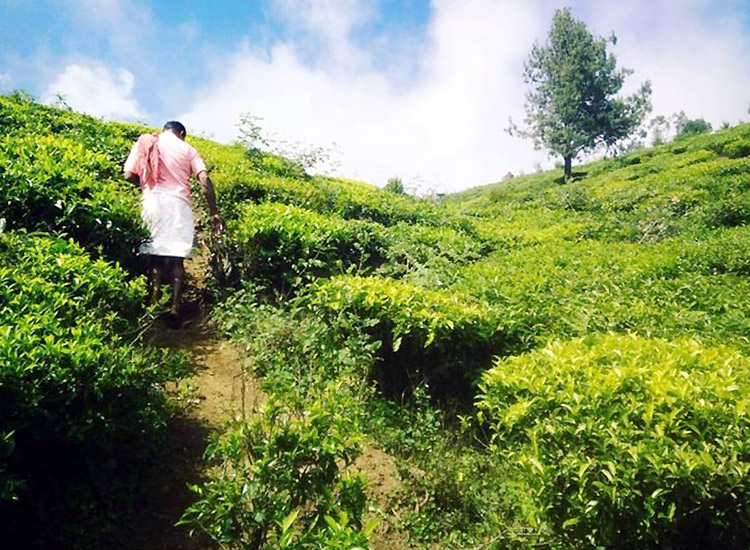
Nothing is better than the feeling of sipping freshly brewed cup of tea on a misty mountain boasting of the highest organic tea plantations in the world. Nestled in Kottagudi, Kolukkumalai Tea Estate is a historical place in Tamil Nadu where tea is still made by hand. Since its establishment, nothing has changed much. None of the computerized system or modern machines have been introduced here. Many of the ancient machines still flaunt the time stamps dating back to 1940s and labels of the English manufacturers.
Started in – early 1900s
Started by – a Scottish planter
Interesting Facts – Reaching to the world’s highest tea plantation requires crossing endless hiking trails that will beguile you with astounding views. The tea grown here is of fine quality and retain its original flavor. The distinctive aroma of the tea lingers in the mouth for long. The tea estate has won the Golden Leaf Award by the Tea Boards of USA and India for its excellent tea quality.
Rama Setu, between Pamban and Mannar Island

A bridge has been the center of attraction for yesteryears. Call it Rama’s Bridge or Adam’s Bridge, Rama Setu is a chain of limestone shoals between Pamban Island and Mannar Island. Many legends are associated with the bridge which makes it the hot topic to talk about. It was reported that the bridge could be traversed on foot up to the 15th century. But now, the navigation is hindered because of the shallowness that varies at different points. The causeway is not only revered by the Hindus but also holds a special place in the hearts Muslims and Christians as well.
Built in – The first mention of the bridge can be found in the ancient Indian Sanskrit epic Ramayana.
Built by – If mythology is to be believed, the bridge was built by the Vanara Sena (army of monkeys) of Lord Rama. But scientific studies put a question mark on it and determine that the bridge was formed naturally by limestone shoals.
Interesting Facts – The Rama Setu is visible via aerial view even today. The causeway was walkable till 15th century. The study of Oceanography reveals that Palk Strait is 7000 years old which sync with Ramayana. It is still not clear that whether the bridge is man-made or naturally formed.
[Live the Tamil Nadu history with its heritage hotels. ]
Nataraja Temple, Chidambaram

The Nataraja Temple or Thillai Nataraja Temple or the Chidambaram Temple revers God Shiva as the lord of dance also called as the Natraja. The architectural grandeur of the temple exemplify the link between spirituality and arts, the divine and creative activity. The holy place is recognized as one of the oldest surviving active temple complexes in South India. 108 karnas from the Natya Shastra are carved on the walls of the temple. Moreover, these postures have laid a foundation of a classical Indian dance form known as Bharatnatyam. It also represents one of the Pancha Bootha Sthalams of the almighty.
Built in – The present shrine was built in 10th century.
Built by – It was under the patronage of the rulers of Chola Dynasty that made the temple what it is today.
Interesting Facts – The Nataraja Temple is one of the five elemental lingams in the Shaivism pilgrimage tradition. A unique feature of this temple is the bejeweled idol of Nataraja that depicts Lord Shiva performing the Ananda Tandava.
Ekambareswarar Temple, Kanchipuram

With Lord Shiva as the presiding deity, Ekambareswarar Temple is one of the popular temples of Tamil Nadu. Located in Kanchipuram, the temples is also one of the five panchabootham temples in India. Innumerable pilgrims thong the sanctum sanctorum every year. Two legends associated with the temple show the sheer devotion of Goddess Parvati towards the Lord Shiva. The huge shrine with high rising Gopurams overpowers the skyline of Kanchipuram. The glory of the temple has been sung by all the four Saivite Saints.
Built in – Before 600 AD
Built by – Cholas, Pallavas and the Vijayanagar Kings especially Krishna Deva Raya have contributed to this temple.
Interesting Facts – No separate shrine for Goddess Parvati exists here and she is worshipped along with Shiva. Another important feature of the complex is a 3500-years old mango tree which is said to be the personification of the four Vedas. Further, the tree is said to bear fruits of four different types of mangoes on its four branches.
Chitragupta Temple, Kanchipuram

The Chitragupta Temple in Kanchipuram is one of the rarest temple of Chitragupta, the minister and chief accountant of Lord Yama. It is a common belief that whosoever worships Chirtragupta at the temple, he or she gets blessed with wealth and prosperity. It also reduces the bad effects caused due to the Kethu, one of the nine planets which affect the fortune of a person. Shri Chitragupta along with Shri Karnagi Ambal dwells in the sanctum sanctorum of the complex. Chitra Pournami in the month of April lures various tourists to this historic temple in Tamil Nadu.
Built in – 9th century
Built by – Medieval Cholas
Interesting Facts – Chitragupta is believed to have emerged from a painting drawn by Shiva. He was given the responsibility of recording the good and bad deeds of the human beings by the almighty.
As now you are aware of the important heritage sites of Tamil Nadu, plan a trip soon to marvel at the monuments which add to the glory of the country.


Wow!! Great post!! you have covered almost all the historical and cultural places in Tamilnadu!!! Tamilnadu is the capital of Tradition, Culture, History, Spiritual, and so on. Of course, there is a lot more to share. I have visited a few places that you have mentioned and should go to the remaining places sooner.
Thank you!!